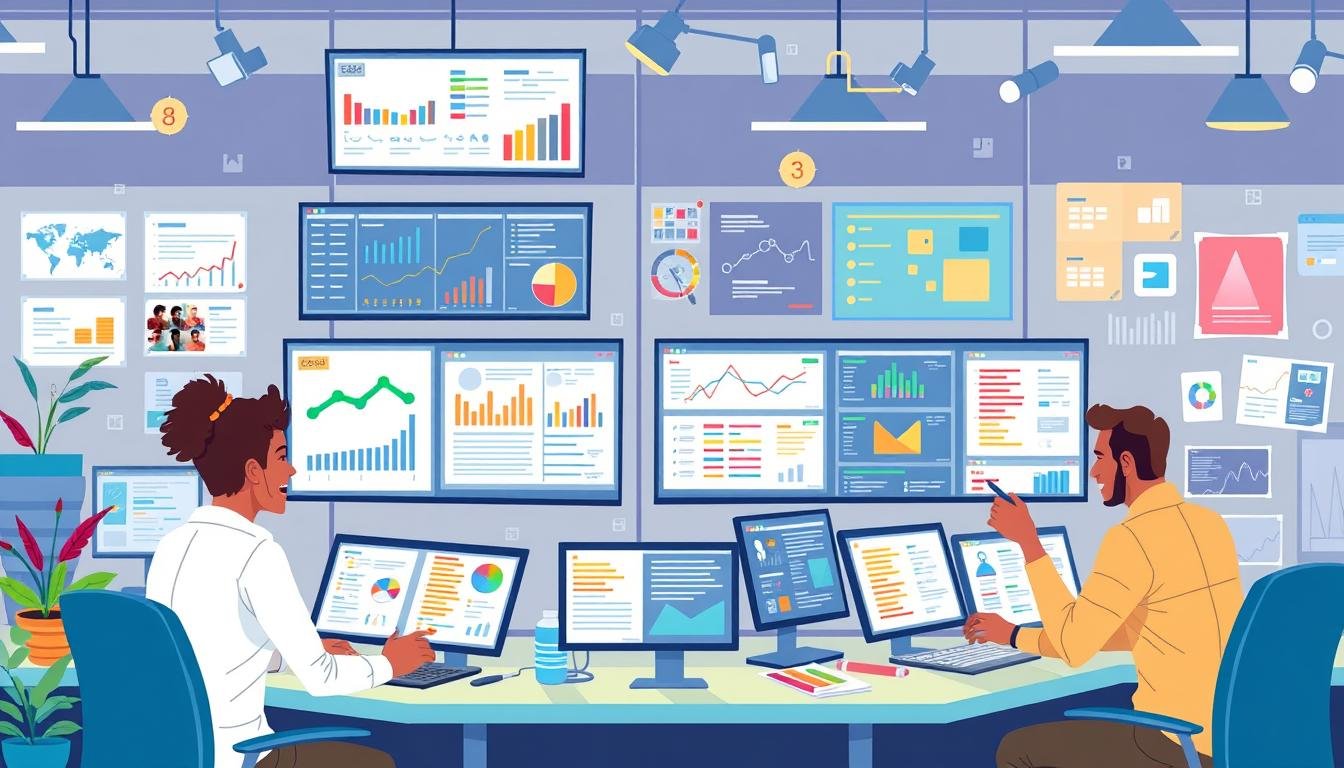The healthcare world has changed a lot in recent years. This change is thanks to new digital health technologies. These tools make healthcare more personal, efficient, and easy to get.
Telehealth services and mobile health apps are now big parts of healthcare. Wearable devices also play a key role. Digital health is making healthcare better for everyone.
The COVID-19 pandemic made digital health even more important. It helped healthcare providers and patients deal with social distancing. This led to more funding and support for digital health.
Key Takeaways
- Digital health technologies are everywhere in healthcare. There are over 350,000 health apps out there. About 90,000 new ones are made every year.
- Telehealth visits skyrocketed during the pandemic. In some U.S. states, visits went from 2.1 million to 32.5 million.
- Digital tools like electronic records and automated devices help reduce mistakes in healthcare.
- Big data, AI, IoT, and wearable devices make healthcare more precise and less prone to errors.
- But, there are challenges too. Low digital health literacy and poor app design are issues. So is resistance to change and a lack of strong rules.
Introduction to Digital Health Technologies
The healthcare world has seen a big change with new digital health technologies. The World Health Organization (WHO) says digital health is about using digital tools to make health better. This includes things like apps, sensors, AI, and the Internet of Things (IoT).
Definition and Significance of Digital Health Technologies
Digital health technologies are key to better patient care and smoother healthcare processes. They help make decisions based on data, offer care that fits each person, and let doctors check on patients from afar. These technologies are changing healthcare in many ways, from finding problems to treating them and managing care over time.
Historical Overview and Current State
The use of digital tools in healthcare started in the late 20th century. At first, it was about making things run smoother and cutting down on mistakes. Now, we’re focusing on using digital tools for data, making decisions, and remote care. The COVID-19 pandemic has made digital health tools even more important for healthcare.
Today, we have many new technologies like machine learning, wearable devices, and telehealth. These are making care better and changing how we do things in clinics. There’s also more focus on genomics, AI in making decisions, and the Internet of Medical Things (IoMT) for more personalized care.
“The digital health revolution is here, and it’s transforming the way we approach healthcare. By harnessing the power of technology, we’re able to deliver more personalized, efficient, and accessible medical services to patients around the world.”
| Key Digital Health Technologies | Applications |
|---|---|
| Telemedicine | Remote patient consultations, virtual care delivery |
| Wearable Devices | Continuous health monitoring, chronic disease management |
| Mobile Health Apps | Patient engagement, self-care management |
| Electronic Health Records (EHRs) | Data storage, clinical decision support, interoperability |
| Artificial Intelligence (AI) | Diagnostics, risk identification, personalized treatment plans |
Digital Health Technologies in Patient Care
Digital health technologies are changing how we care for patients. Telemedicine is a big part of this change. It lets patients talk to doctors from home, especially when they can’t go to the doctor’s office.
Remote patient monitoring is also key. It uses things like wearable devices and IoT sensors to track health. This way, doctors can keep an eye on patients’ health without being in the same room.
Mobile Health Apps and Wearable Devices
Mobile health apps are becoming very popular. They help patients manage their health in many ways. These apps make it easier for patients and doctors to stay in touch.
Wearable devices are also important. They give real-time health data, like heart rate and sleep. This helps patients take better care of themselves and improves their health.
| Digital Health Technology | Key Benefits |
|---|---|
| Telemedicine | Improved access to care, reduced travel time and costs, enhanced patient convenience |
| Remote Patient Monitoring | Continuous health data collection, early detection of health issues, better-informed care decisions |
| Mobile Health Apps | Improved patient engagement, better self-management of health, enhanced communication with providers |
| Wearable Devices | Real-time health data tracking, personalized wellness insights, remote monitoring of chronic conditions |
Digital health technologies are making patient care better in many ways. They help patients and doctors work together more effectively. As healthcare keeps changing, these technologies will be even more important for the future of patient care.

“The rise of digital health technologies in patient care is transforming the healthcare landscape, empowering patients and providers alike to deliver more personalized, efficient, and effective care.”
The Rise of Digital Health: How Technology is Improving Patient Care
The healthcare world is changing fast, thanks to digital health tech. These new tools are changing how we care for patients. They make care better, more efficient, and more satisfying for patients.
The global healthcare IT market hit $199.5 billion in 2023. It’s expected to grow 18.7% each year from 2024 to 2030. This shows how big of an impact digital health tech is having.
Electronic health records (EHRs) are a big deal. They let doctors share patient info quickly, making care better. Practices using EHRs make more money and spend less, thanks to better data management and billing.
Artificial intelligence (AI) is also changing healthcare. AI-powered clinical decision support systems help doctors make better choices. As AI gets smarter, we’ll see even better diagnosis of tough conditions.
Telemedicine and remote patient monitoring are also big wins. They’ve been especially helpful during the pandemic. They let doctors care for patients from afar, reaching more people in remote areas.
But, there are challenges too. Like keeping patient data safe and making sure AI is used right. Still, the move to digital health is making a big difference. It’s shaping a future where tech helps care for patients better.
“The intersection of technology and healthcare has started a new phase in medical care, where these tools don’t just support but significantly boost healthcare services.”
Electronic Health Records (EHRs)
The healthcare world has changed a lot with electronic health records (EHRs). EHRs are digital versions of medical charts. They give real-time info on patients’ health to both patients and doctors. This helps doctors track health over time and improve care.
Benefits of EHRs in Patient Care
EHRs have many benefits for patient care:
- Improved Patient Care: EHRs give complete and current patient info. This cuts down on medical mistakes and helps with preventive care.
- Enhanced Healthcare Efficiency: EHRs make admin tasks easier. They cut down on paperwork, save time, and make work flow better for doctors.
- Increased Accessibility and Coordination: EHRs let doctors see patient info from anywhere. They help doctors work together better, improving care coordination.
But, there are also challenges with EHRs. The cost of starting up, resistance from staff, and issues with different systems can slow things down.
Keeping patient info safe is very important. Rules like HIPAA help keep data secure. But, data breaches can still happen. They can let unauthorized people see patient info, so strong security plans are needed.

Despite the challenges, EHRs are changing healthcare for the better. By 2015, over 80% of U.S. hospitals were using EHRs. The benefits of EHRs keep pushing the healthcare industry towards digital change.
Artificial Intelligence in Healthcare
Artificial intelligence (AI) is changing healthcare in big ways. It’s making diagnoses and treatments better. AI helps by analyzing data to improve patient care.
Healthcare is facing big challenges like a shortage of workers and the need for better care. AI can help by making diagnoses and treatments more accurate. This reduces mistakes and improves care for patients.
AI-Assisted Clinical Decision Support Systems
AI systems look at lots of data in electronic health records and other sources. They give doctors personalized advice based on this data. They use smart algorithms to find patterns that humans might miss.
AI helps doctors make better choices and work more efficiently. AI-assisted systems have shown great results in finding diseases early, choosing treatments, and managing risks.
| AI Application | Improvement over Human Performance |
|---|---|
| Breast Cancer Diagnosis | Reduced false positives by 5.7% and false negatives by 9.4% |
| Melanoma Detection | Accurately diagnosed and recommended treatment options |
| Diabetic Retinopathy Screening | Improved early detection and management of the disease |
Even though AI in healthcare is promising, it’s not used much yet. To use AI well, we need to focus on people and solve real problems. This approach helps healthcare organizations and patients.
“AI is considered the most transformational technology, with healthcare being its most pressing application.”
– Satya Nadella, CEO of Microsoft
By using AI-assisted clinical decision support systems, healthcare can get better at diagnosing and treating patients. This leads to better outcomes and helps solve the big challenges in healthcare.

Virtual Reality and Augmented Reality in Healthcare
The healthcare world is changing fast with virtual reality (VR) and augmented reality (AR). These new tools are making patient care better and changing how doctors work. They are making healthcare delivery more effective.
VR systems help patients follow their rehab plans after surgery. They can explore virtual worlds, making rehab more fun and helpful. Now, there are special codes for remote doctor visits, and VR therapy is available outside hospitals too.
AR is also making a big difference. It adds digital info to the real world, helping doctors during surgeries. This makes surgeries safer and more precise. AR also helps patients learn about their health, making them more involved in their care.
VR and AR have many uses in healthcare. They help with kids’ health, pain management, and mental health. These tools can bring care to people’s homes, helping those who can’t get to hospitals easily.
The future of healthcare looks bright with VR and AR. These technologies could change patient care in big ways. They promise better health outcomes, more access to care, and better teamwork between patients and doctors.
| Metric | Value |
|---|---|
| Number of medical devices incorporating AR/VR authorized by the FDA | 69 as of September 6, 2024 |
| Potential benefits of AR/VR in healthcare |
|
| Potential risks associated with AR/VR in healthcare |
|
“AR/VR technologies have the potential to transform healthcare by delivering new types of treatments and changing how and where care is provided.”
Internet of Things (IoT) and Big Data Analytics
Digital health technologies have changed healthcare forever. Wearable devices and remote monitoring are collecting a lot of patient data. This data is helping doctors make better decisions and save lives.
Healthcare Data Analytics and Precision Medicine
Healthcare data analytics is leading this digital change. It helps doctors find patterns in huge amounts of data. This leads to better patient care and treatment plans.
Precision medicine is a big win for this technology. It lets doctors give patients advice based on their unique needs. This approach is making healthcare more personal and effective.
| Key Statistic | Value |
|---|---|
| By 2020, 40% of IoT-related technology will be health-related, making up a $117 billion market. | $117 billion |
| The global digital health market is projected to reach $1,011.07 billion in 2028. | $1,011.07 billion |
| The IoT medical devices market is anticipated to reach a value of $203.13 billion in 2028. | $203.13 billion |
| About 86% of healthcare providers in the US have adopted Electronic Health Records (EHR) systems. | 86% |
The future of healthcare looks bright with IoT and big data analytics. These technologies are making care more personal and effective. We’re moving towards a future where everyone gets the best care possible.
Robotic Surgery and Rehabilitation Systems
Robotic technology is changing healthcare in big ways. It’s making patient care and treatment better. From surgeries to rehab, robots are improving health outcomes and medical services.
Robotic surgery is a key area where robots help a lot. The da Vinci Surgical System by Intuitive Surgical is a top example. It lets surgeons do complex, small procedures with great precision and control.
These robots have advanced cameras and tools that give surgeons better views and control. This means patients can recover faster and have better surgery results.
Robots also play a big role in rehabilitation systems. They include robotic exoskeletons and prosthetics like the Lokomat® by Hocoma and the Hybrid Assistive Limb (HAL) by Cyberdyne. These help patients move again after injuries or amputations.
These technologies improve lives by helping people with physical disabilities. They make rehab easier and better.
Robots are used in many healthcare areas, not just surgery and rehab. They help in labs by making work faster and less error-prone. They also help in telemedicine, making it easier to see doctors from far away.
The future of healthcare looks bright with robotic technology. As more robots are used, we’ll see even more improvements in patient care. This will change how we treat and help patients.
Challenges and Limitations of Digital Health Technologies
Digital health technologies bring many benefits, but they also face big challenges. For patients, not being able to use these technologies because of low digital skills or lack of access is a major issue. This is especially true for older adults and those with less digital knowledge.
Also, if apps are not designed well, it can make it hard for people to use them. This can stop them from getting the benefits of these technologies.
Another big problem is the lack of strict rules to check if these technologies work well. This can make people doubt their value. There are also worries about keeping patient information safe and private.
Regulatory Considerations and Quality Assurance
The digital health field has to deal with rules to make sure their products are good and work as promised. It’s important to have clear rules and ways to check if these technologies are effective. Healthcare workers and lawmakers need to work together to make sure these technologies are trustworthy.
Patient Privacy and Data Security
Using digital health technologies means dealing with sensitive patient data. This raises big questions about privacy and keeping data safe. It’s crucial to have strong protection for data, clear rules for sharing it, and good security to keep patient trust.
| Challenges | Limitations |
|---|---|
|
|
By tackling the challenges of digital health technologies and limitations of digital health technologies, we can make them better. This will help improve care for patients and lead to better health outcomes. Everyone involved needs to work together to make sure these technologies are safe, private, and effective.
“The integration of digital health technologies into healthcare systems is a complex challenge that requires a multifaceted approach to address regulatory considerations, quality assurance, and patient privacy concerns.”
Future Trends in Digital Health
Digital tools are changing healthcare fast. They promise to make patient care better. With more older people and chronic conditions, we need tech like telehealth and AI to help.
Data analytics and precision medicine will also change digital health. They help doctors give better care. New tech like virtual reality and robotics will make care even better.
The market for healthcare info systems is growing fast. It’s expected to almost double by 2030. This shows digital health is becoming a big part of healthcare.
The home healthcare sector is also growing. It’s expected to reach $666.9 billion by 2030. New medical tech has already helped a lot of people, showing digital health’s power.
But, there are challenges ahead. We need to make sure data is shared right, keep patient info safe, and follow rules. Yet, tech will make healthcare better in many ways.
| Trend | Impact |
|---|---|
| Telehealth and Remote Monitoring | Improved access to care, especially for patients in remote or underserved areas, and better management of chronic conditions. |
| AI-Powered Decision Support | Enhanced clinical decision-making, streamlined administrative processes, and personalized treatment recommendations. |
| Precision Medicine | Targeted interventions based on individual genetic, environmental, and lifestyle factors for improved patient outcomes. |
| Virtual and Augmented Reality | Innovative approaches to patient education, rehabilitation, and surgical planning. |
| Internet of Medical Things (IoMT) | Expanded opportunities for remote patient monitoring, data-driven care, and enhanced patient engagement. |
The future of digital health looks bright. It will make healthcare better for everyone. With new tech, doctors can give care that’s more personal and effective.
Conclusion
Digital health technologies have changed the healthcare world. They offer new ways to better care for patients. From telemedicine to AI, these tools are making care more personal and efficient. The future looks bright for using tech to make healthcare better and more affordable.
But, there are challenges like regulation and keeping patient data safe. Overcoming these will help healthcare use digital tools fully. This will lead to better care and a healthier society.
Digital health can make healthcare smoother and more personal. As these tools get better, I’m hopeful for even more progress. We’ll see healthcare that’s better, more accessible, and affordable for everyone.






